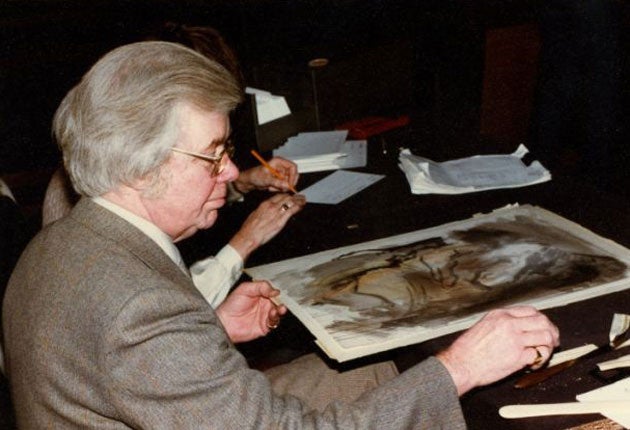Cyril Fry: Art dealer and restorer who became a pre-eminent collector of watercolours

The art dealer Cyril Fry learnt his trade as an amateur collector. It was still possible in the years after the war to browse through piles of neglected, unattributed sketches and drawings sold by the second-hand dealers and junkshops around Charing Cross Road and Portobello Road and make finds – sometimes of significance – which could be purchased for a few shillings. Only a few collectors and art historians were interested in the trade, which was regarded as quaint and unfashionable. When in 1994 what Fry called "the subtle modesty of the medium" of watercolour had become more fully appreciated, it was only appropriate that near the end of his career he should have curated at Gainsborough House in Sudbury an exhibition under the title "A Peculiarly English Art".
Fry was born in Forest Gate, east London in 1917. His father, a carpenter, and his mother were profoundly deaf and from childhood he learnt to communicate by sign language. He left school at 14 to work as an office boy. By chance, an early employer was the solicitor for the greatest dealer of his day, Joseph Duveen, whose rise was based on his understanding that "Europe had plenty of art and America had plenty of money". After the collapse of the Hungarian currency, Fry found Hungarian banknotes in Duveen's wastepaper basket: it was the beginning of his own collecting career.
In September 1938 Fry joined the London Scottish Regiment of the Territorial Army, and a year later volunteered for the Indian Army. He spent four years in GHQ in Delhi, eventually becoming a warrant officer. During his time he secured improvements in conditions on board the troop ships.
On his return to England Fry trained as a teacher of deaf children (he did not inherit the disability), and taught in schools in Old Street and in Greenwich. He also appeared as a sign-language storyteller on a BBC television programme, For Deaf Children. However after 18 years of teaching, Fry became so unhappy and so deeply opposed to educational developments that he resigned and embarked upon a career as dealer in watercolours.
In a memorial address given in 1992 for Dudley Snelgrove Fry recalled how, some 40 years earlier, he had taken to the British Museum a watercolour by the Victorian artist William Leighton Leitch which he had bought for £1 in an antique shop. This encounter with Snelgrove, an assistant in the museum's department of prints and drawings, and Edward Croft-Murray, the department keeper, opened up a whole new world. He and a group of fellow enthusiasts would gather to discus works in the museum. Snelgrove was a born teacher.
These new connections led Fry into wider company. He attended informal salons in Notting Hill held by the maternal figure of Mady Stritzl, where young collectors of limited means could bring their newly purchased drawings for examination; sometimes they would be joined by more considerable collectors and scholars such as Paul Oppé. Maids in black dresses and white aprons served tea and bridge rolls.
Encouraged to learn restoration techniques from the museum staff, Fry set up a workshop in his Westminster flat where he did mounting and framing (abilities he had learnt from his father). To begin with, he sold from the flat and later from his house in Blackheath, but he began business seriously in a small gallery at 59 Jermyn Street where he bought a 21-year lease. His first show sold out on its opening night. He also exhibited at the galleries of the Alpine Club and the Royal Surgical Aid Society near the British Museum. In 1972 he opened a second gallery, at Aldeburgh in Suffolk, where he exhibited during the Festival.
In 1971 Fry became responsible for dealing with the estate of Leonard Duke. A retired school inspector, Duke was one of the greatest collectors of English watercolours of the 20th century. During the course of his collecting career literally thousands of pictures had passed through his hands, many of which ended up at the Paul Mellon Center at Yale University in the US. Duke ahd directed that his personal correspondence and diaries be destroyed after his death, but a copy was made of his manuscript catalogue, which he kept by his bed, and given to the British Museum; Fry also rescued letters illustrated by Muriel Eldridge (the wife of the poet RS Thomas) and gave them to the Royal Watercolour Society.
Fry's preference was for the 18th and early 19th centuries. His exhibitions included a Peter De Wint bicentennial; insects and reptiles in Indian ink by the 18th-century artist Richard Brookes; drawings from an Italian Journey by Duffield Harding; Hester Frood; the Suffolk artist and architect Cecil Lay; and the Welsh artist Enaid Jones.
In 1982 at Bankside Gallery, the home of the Royal Watercolour Society, he organised the exhibition "John Middleton and the Norwich School". He was further involved with the society when, a few years later, he helped assess and value its own collection – neglected for decades – prior to conservation.
Discerning, intelligent and blunt in his opinions, Fry was helpful and encouraging to others eager to learn, just as he had learnt from others. He was a small sturdy man whose deteriorating eyesight forced him to wear thick glasses. When the Jermyn Street lease ended, he and his wife Shirley, a JP and prison visitor and a constant support in his business, moved to Snape in Suffolk, where they kept sheep.
Cyril Fry, art dealer: born London 27 May 1918; married 1948 Shirley Bartrum (three sons, one daughter); died Snape, Suffolk 10 November 2010.
Subscribe to Independent Premium to bookmark this article
Want to bookmark your favourite articles and stories to read or reference later? Start your Independent Premium subscription today.

Join our commenting forum
Join thought-provoking conversations, follow other Independent readers and see their replies